Financial Mathematics: Interest, Annuities, and Present Value Analysis
VerifiedAdded on 2021/04/21
|12
|1252
|127
Homework Assignment
AI Summary
This financial mathematics assignment solution covers a range of topics including simple interest, compound interest, present value, and annuities. The solution demonstrates the calculation of simple interest, both exact and ordinary, and explores the difference between them. It also includes the computation of compound interest with different compounding frequencies (annually, semi-annually, quarterly, and monthly). Furthermore, the assignment delves into present value calculations, rate of return, and the time value of money. The document provides detailed examples and formulas to illustrate each concept, including the present value of annuities at different interest rates. The assignment aims to provide a comprehensive understanding of key financial mathematics principles.
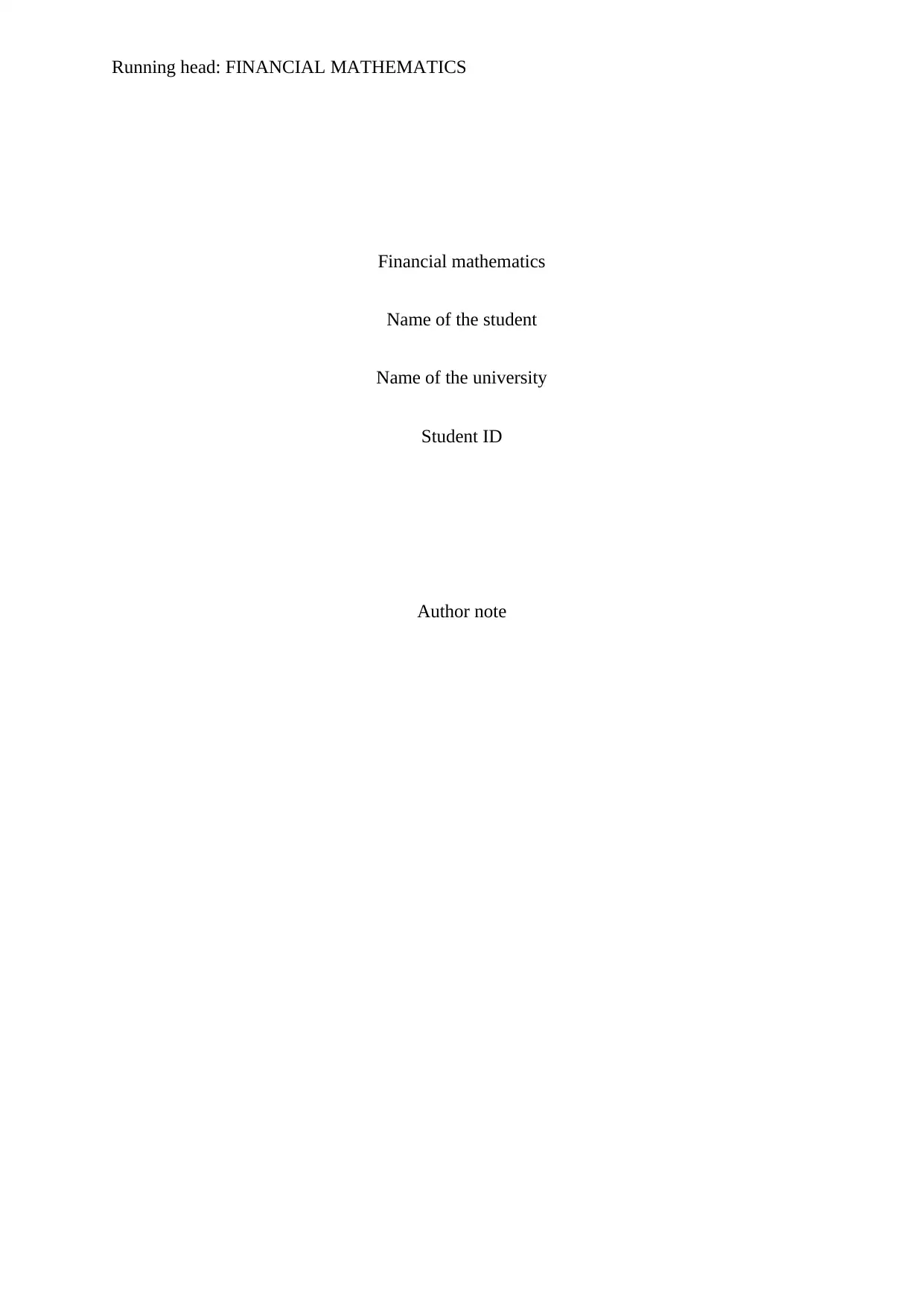
Running head: FINANCIAL MATHEMATICS
Financial mathematics
Name of the student
Name of the university
Student ID
Author note
Financial mathematics
Name of the student
Name of the university
Student ID
Author note
Paraphrase This Document
Need a fresh take? Get an instant paraphrase of this document with our AI Paraphraser
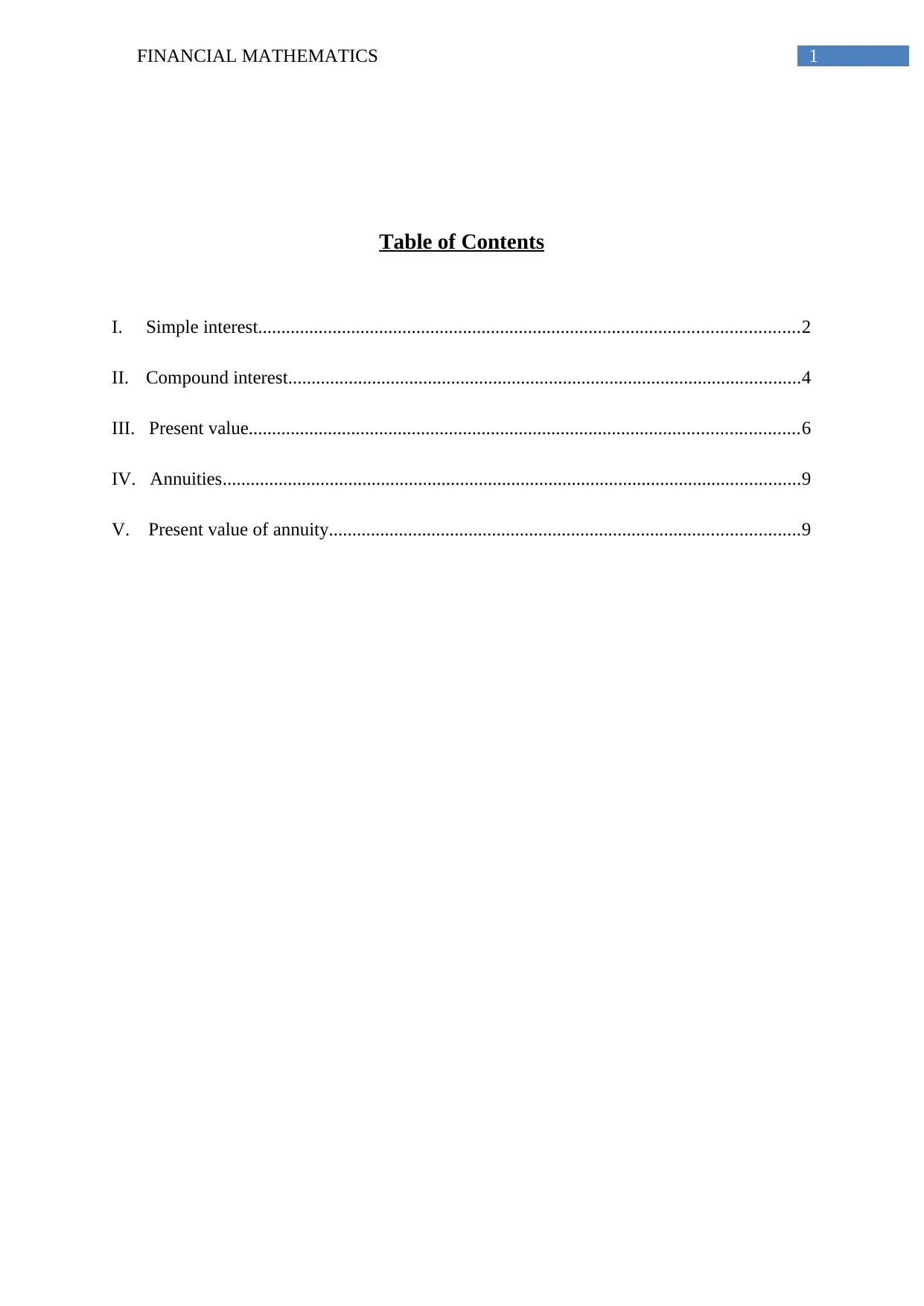
1FINANCIAL MATHEMATICS
Table of Contents
I. Simple interest....................................................................................................................2
II. Compound interest..............................................................................................................4
III. Present value......................................................................................................................6
IV. Annuities............................................................................................................................9
V. Present value of annuity.....................................................................................................9
Table of Contents
I. Simple interest....................................................................................................................2
II. Compound interest..............................................................................................................4
III. Present value......................................................................................................................6
IV. Annuities............................................................................................................................9
V. Present value of annuity.....................................................................................................9
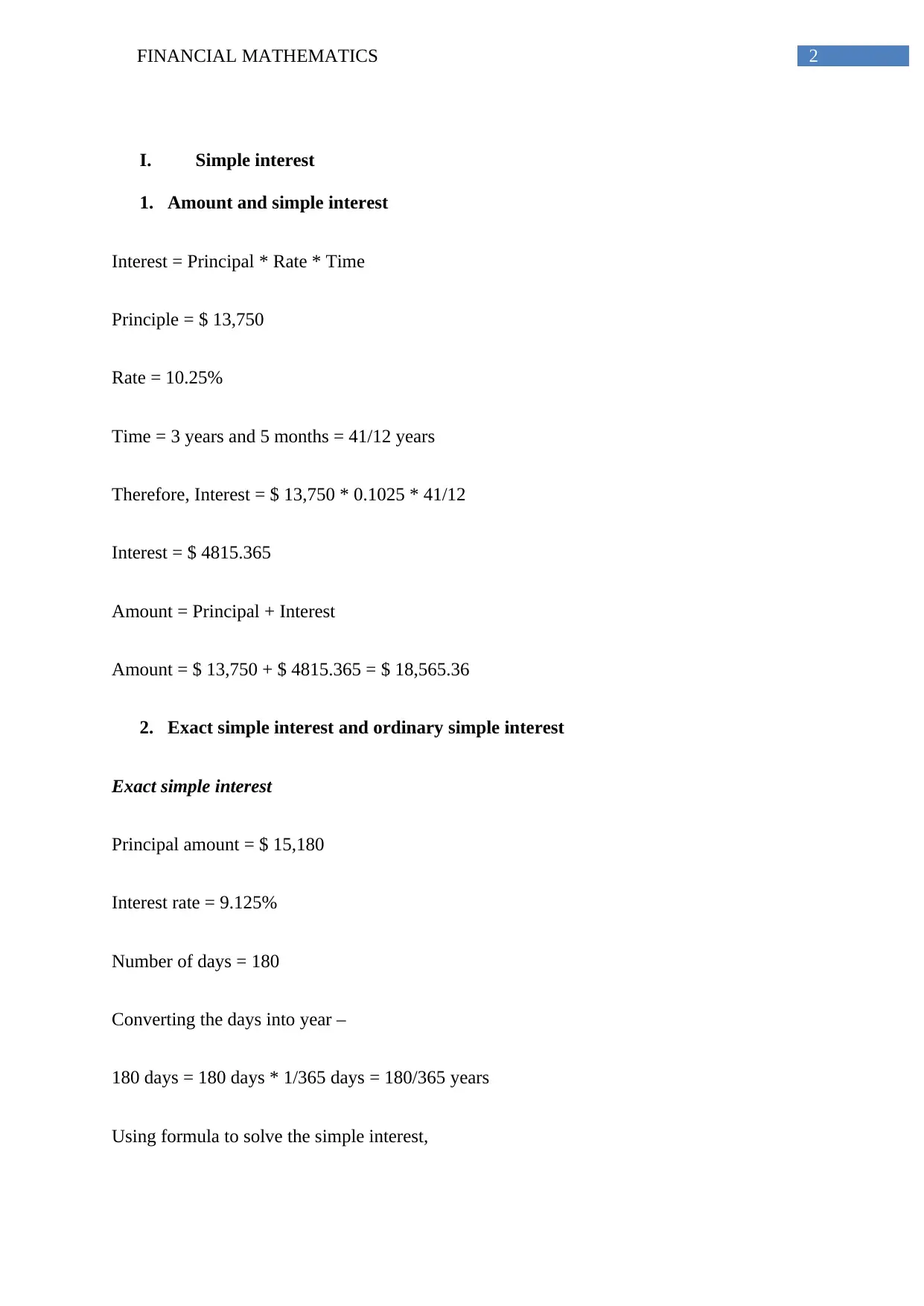
2FINANCIAL MATHEMATICS
I. Simple interest
1. Amount and simple interest
Interest = Principal * Rate * Time
Principle = $ 13,750
Rate = 10.25%
Time = 3 years and 5 months = 41/12 years
Therefore, Interest = $ 13,750 * 0.1025 * 41/12
Interest = $ 4815.365
Amount = Principal + Interest
Amount = $ 13,750 + $ 4815.365 = $ 18,565.36
2. Exact simple interest and ordinary simple interest
Exact simple interest
Principal amount = $ 15,180
Interest rate = 9.125%
Number of days = 180
Converting the days into year –
180 days = 180 days * 1/365 days = 180/365 years
Using formula to solve the simple interest,
I. Simple interest
1. Amount and simple interest
Interest = Principal * Rate * Time
Principle = $ 13,750
Rate = 10.25%
Time = 3 years and 5 months = 41/12 years
Therefore, Interest = $ 13,750 * 0.1025 * 41/12
Interest = $ 4815.365
Amount = Principal + Interest
Amount = $ 13,750 + $ 4815.365 = $ 18,565.36
2. Exact simple interest and ordinary simple interest
Exact simple interest
Principal amount = $ 15,180
Interest rate = 9.125%
Number of days = 180
Converting the days into year –
180 days = 180 days * 1/365 days = 180/365 years
Using formula to solve the simple interest,
⊘ This is a preview!⊘
Do you want full access?
Subscribe today to unlock all pages.

Trusted by 1+ million students worldwide
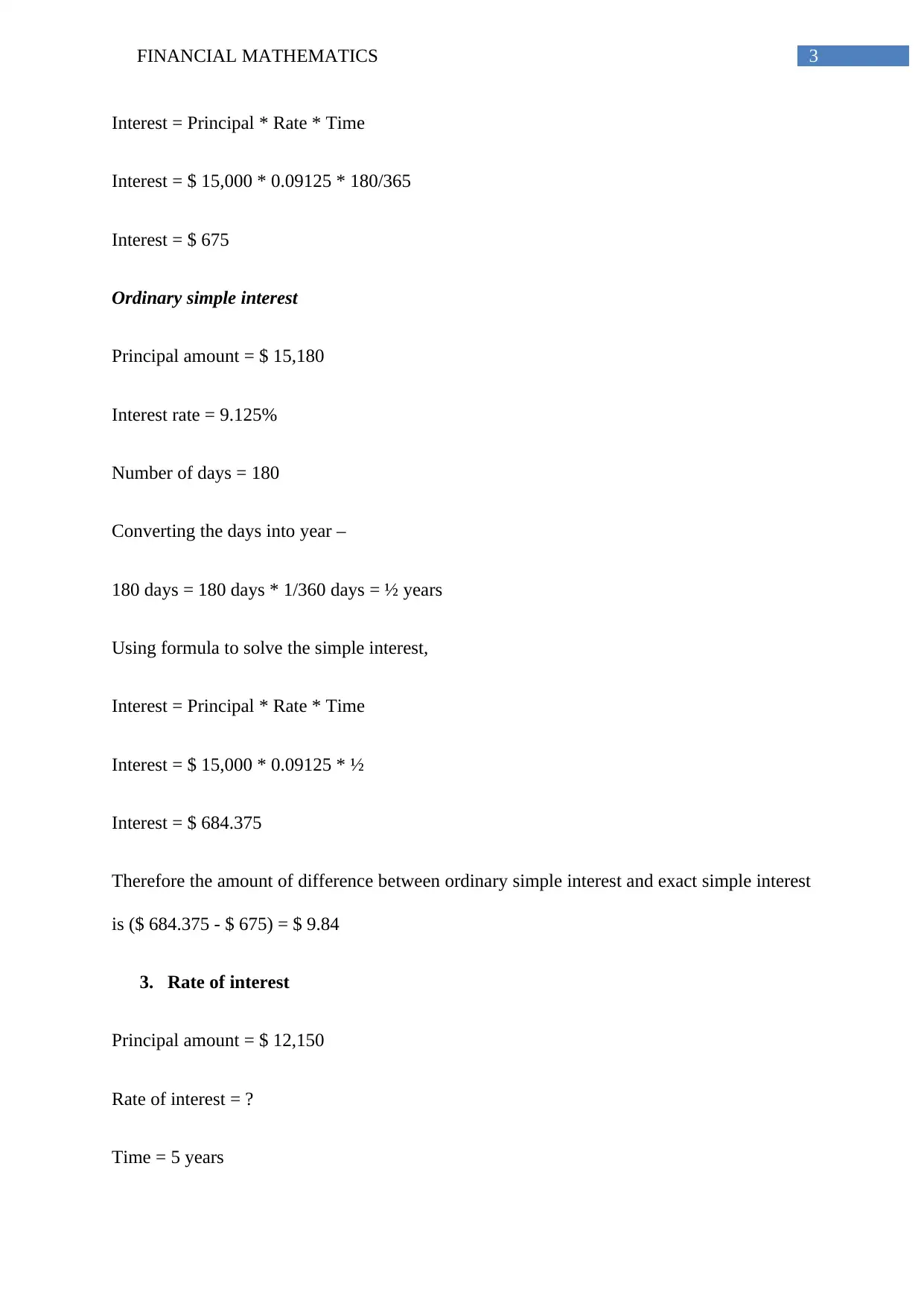
3FINANCIAL MATHEMATICS
Interest = Principal * Rate * Time
Interest = $ 15,000 * 0.09125 * 180/365
Interest = $ 675
Ordinary simple interest
Principal amount = $ 15,180
Interest rate = 9.125%
Number of days = 180
Converting the days into year –
180 days = 180 days * 1/360 days = ½ years
Using formula to solve the simple interest,
Interest = Principal * Rate * Time
Interest = $ 15,000 * 0.09125 * ½
Interest = $ 684.375
Therefore the amount of difference between ordinary simple interest and exact simple interest
is ($ 684.375 - $ 675) = $ 9.84
3. Rate of interest
Principal amount = $ 12,150
Rate of interest = ?
Time = 5 years
Interest = Principal * Rate * Time
Interest = $ 15,000 * 0.09125 * 180/365
Interest = $ 675
Ordinary simple interest
Principal amount = $ 15,180
Interest rate = 9.125%
Number of days = 180
Converting the days into year –
180 days = 180 days * 1/360 days = ½ years
Using formula to solve the simple interest,
Interest = Principal * Rate * Time
Interest = $ 15,000 * 0.09125 * ½
Interest = $ 684.375
Therefore the amount of difference between ordinary simple interest and exact simple interest
is ($ 684.375 - $ 675) = $ 9.84
3. Rate of interest
Principal amount = $ 12,150
Rate of interest = ?
Time = 5 years
Paraphrase This Document
Need a fresh take? Get an instant paraphrase of this document with our AI Paraphraser
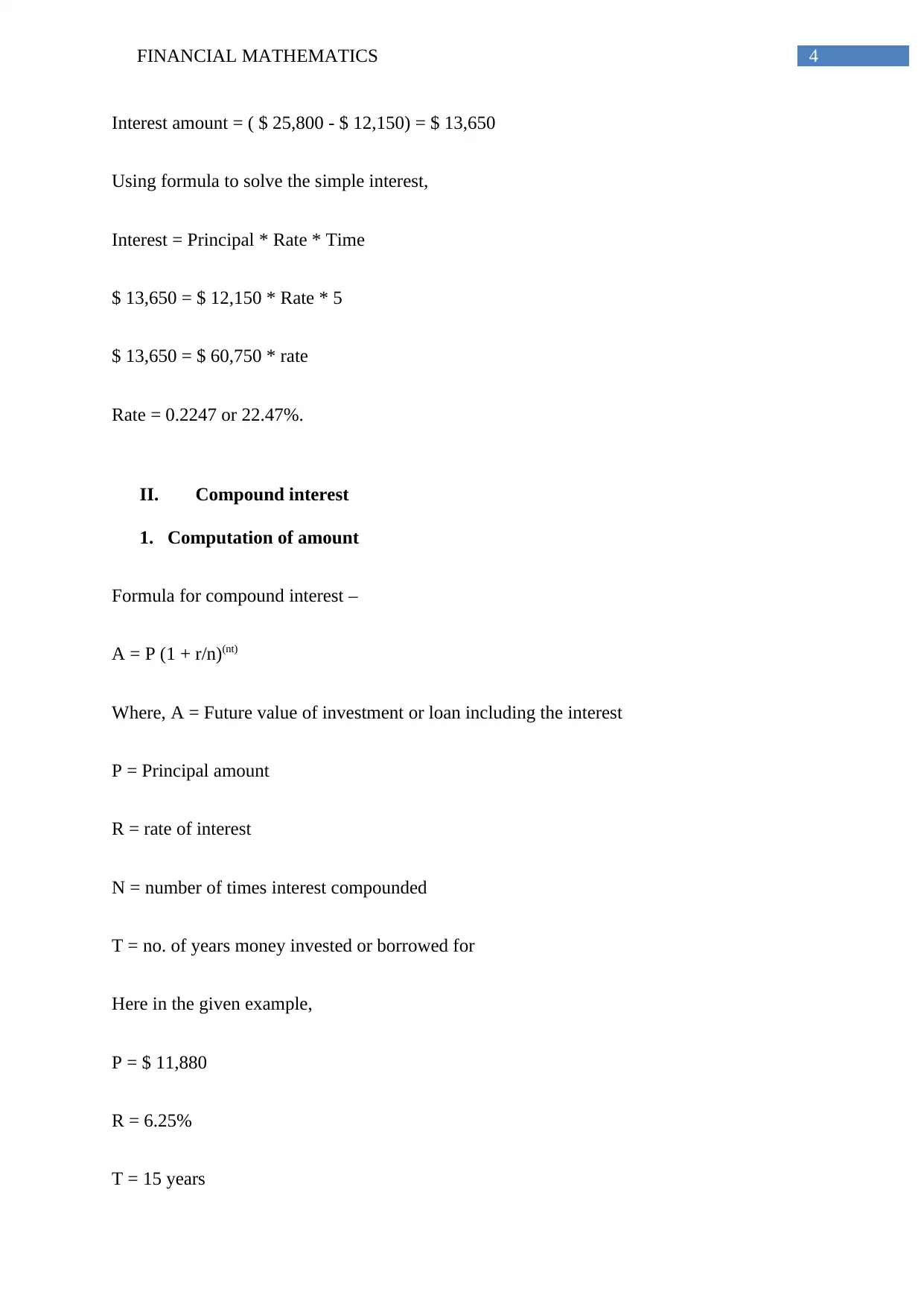
4FINANCIAL MATHEMATICS
Interest amount = ( $ 25,800 - $ 12,150) = $ 13,650
Using formula to solve the simple interest,
Interest = Principal * Rate * Time
$ 13,650 = $ 12,150 * Rate * 5
$ 13,650 = $ 60,750 * rate
Rate = 0.2247 or 22.47%.
II. Compound interest
1. Computation of amount
Formula for compound interest –
A = P (1 + r/n)(nt)
Where, A = Future value of investment or loan including the interest
P = Principal amount
R = rate of interest
N = number of times interest compounded
T = no. of years money invested or borrowed for
Here in the given example,
P = $ 11,880
R = 6.25%
T = 15 years
Interest amount = ( $ 25,800 - $ 12,150) = $ 13,650
Using formula to solve the simple interest,
Interest = Principal * Rate * Time
$ 13,650 = $ 12,150 * Rate * 5
$ 13,650 = $ 60,750 * rate
Rate = 0.2247 or 22.47%.
II. Compound interest
1. Computation of amount
Formula for compound interest –
A = P (1 + r/n)(nt)
Where, A = Future value of investment or loan including the interest
P = Principal amount
R = rate of interest
N = number of times interest compounded
T = no. of years money invested or borrowed for
Here in the given example,
P = $ 11,880
R = 6.25%
T = 15 years
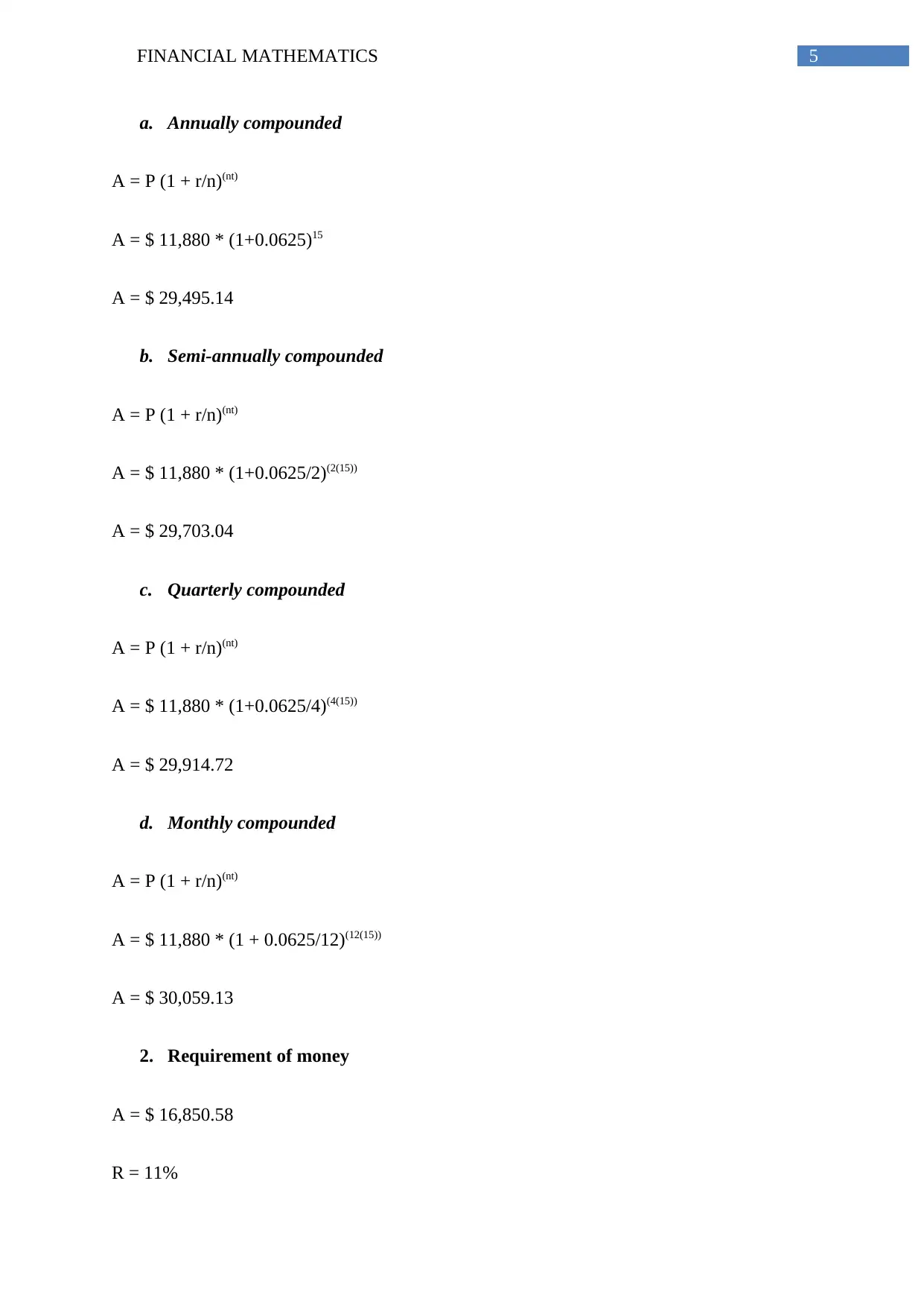
5FINANCIAL MATHEMATICS
a. Annually compounded
A = P (1 + r/n)(nt)
A = $ 11,880 * (1+0.0625)15
A = $ 29,495.14
b. Semi-annually compounded
A = P (1 + r/n)(nt)
A = $ 11,880 * (1+0.0625/2)(2(15))
A = $ 29,703.04
c. Quarterly compounded
A = P (1 + r/n)(nt)
A = $ 11,880 * (1+0.0625/4)(4(15))
A = $ 29,914.72
d. Monthly compounded
A = P (1 + r/n)(nt)
A = $ 11,880 * (1 + 0.0625/12)(12(15))
A = $ 30,059.13
2. Requirement of money
A = $ 16,850.58
R = 11%
a. Annually compounded
A = P (1 + r/n)(nt)
A = $ 11,880 * (1+0.0625)15
A = $ 29,495.14
b. Semi-annually compounded
A = P (1 + r/n)(nt)
A = $ 11,880 * (1+0.0625/2)(2(15))
A = $ 29,703.04
c. Quarterly compounded
A = P (1 + r/n)(nt)
A = $ 11,880 * (1+0.0625/4)(4(15))
A = $ 29,914.72
d. Monthly compounded
A = P (1 + r/n)(nt)
A = $ 11,880 * (1 + 0.0625/12)(12(15))
A = $ 30,059.13
2. Requirement of money
A = $ 16,850.58
R = 11%
⊘ This is a preview!⊘
Do you want full access?
Subscribe today to unlock all pages.

Trusted by 1+ million students worldwide
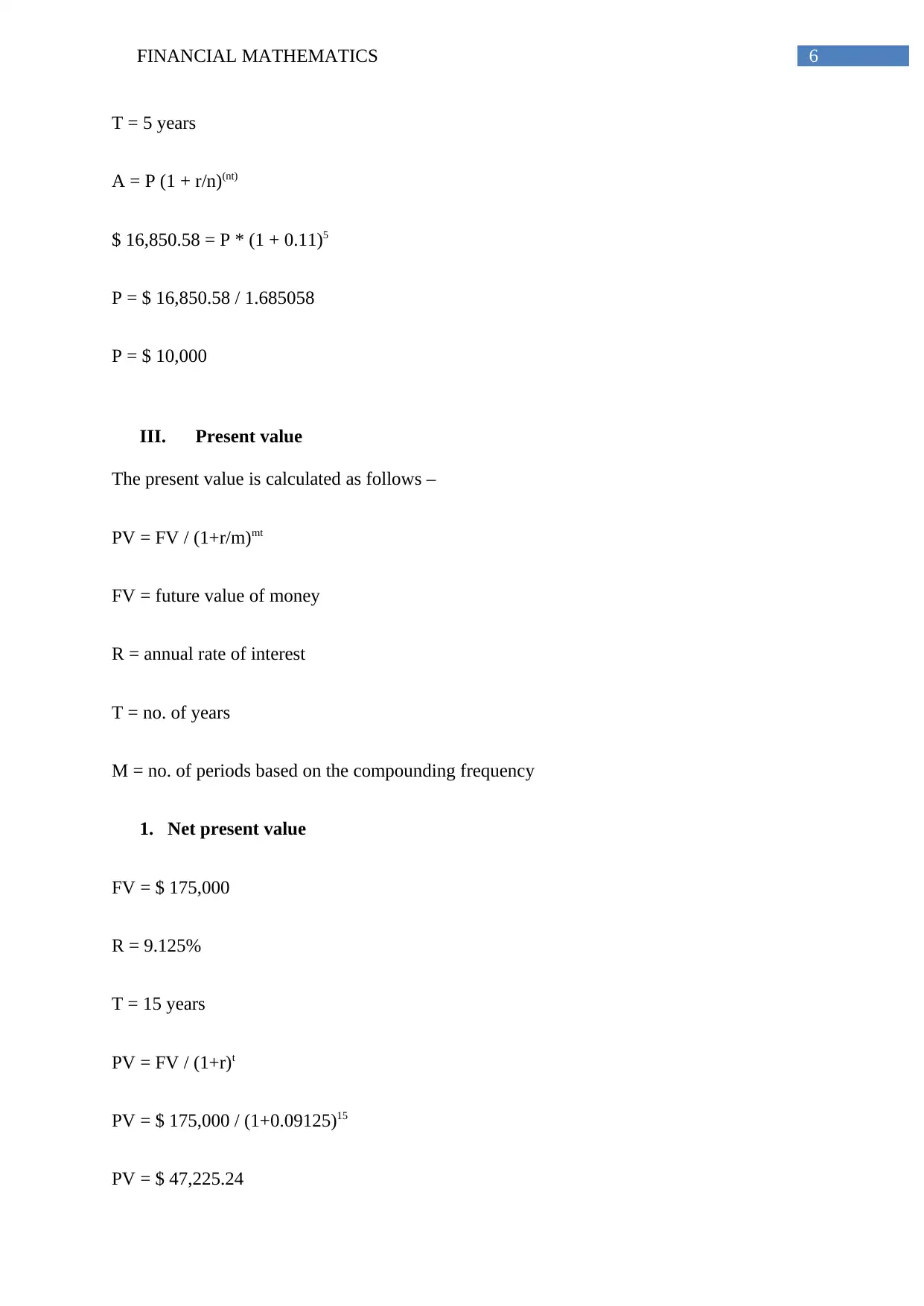
6FINANCIAL MATHEMATICS
T = 5 years
A = P (1 + r/n)(nt)
$ 16,850.58 = P * (1 + 0.11)5
P = $ 16,850.58 / 1.685058
P = $ 10,000
III. Present value
The present value is calculated as follows –
PV = FV / (1+r/m)mt
FV = future value of money
R = annual rate of interest
T = no. of years
M = no. of periods based on the compounding frequency
1. Net present value
FV = $ 175,000
R = 9.125%
T = 15 years
PV = FV / (1+r)t
PV = $ 175,000 / (1+0.09125)15
PV = $ 47,225.24
T = 5 years
A = P (1 + r/n)(nt)
$ 16,850.58 = P * (1 + 0.11)5
P = $ 16,850.58 / 1.685058
P = $ 10,000
III. Present value
The present value is calculated as follows –
PV = FV / (1+r/m)mt
FV = future value of money
R = annual rate of interest
T = no. of years
M = no. of periods based on the compounding frequency
1. Net present value
FV = $ 175,000
R = 9.125%
T = 15 years
PV = FV / (1+r)t
PV = $ 175,000 / (1+0.09125)15
PV = $ 47,225.24
Paraphrase This Document
Need a fresh take? Get an instant paraphrase of this document with our AI Paraphraser
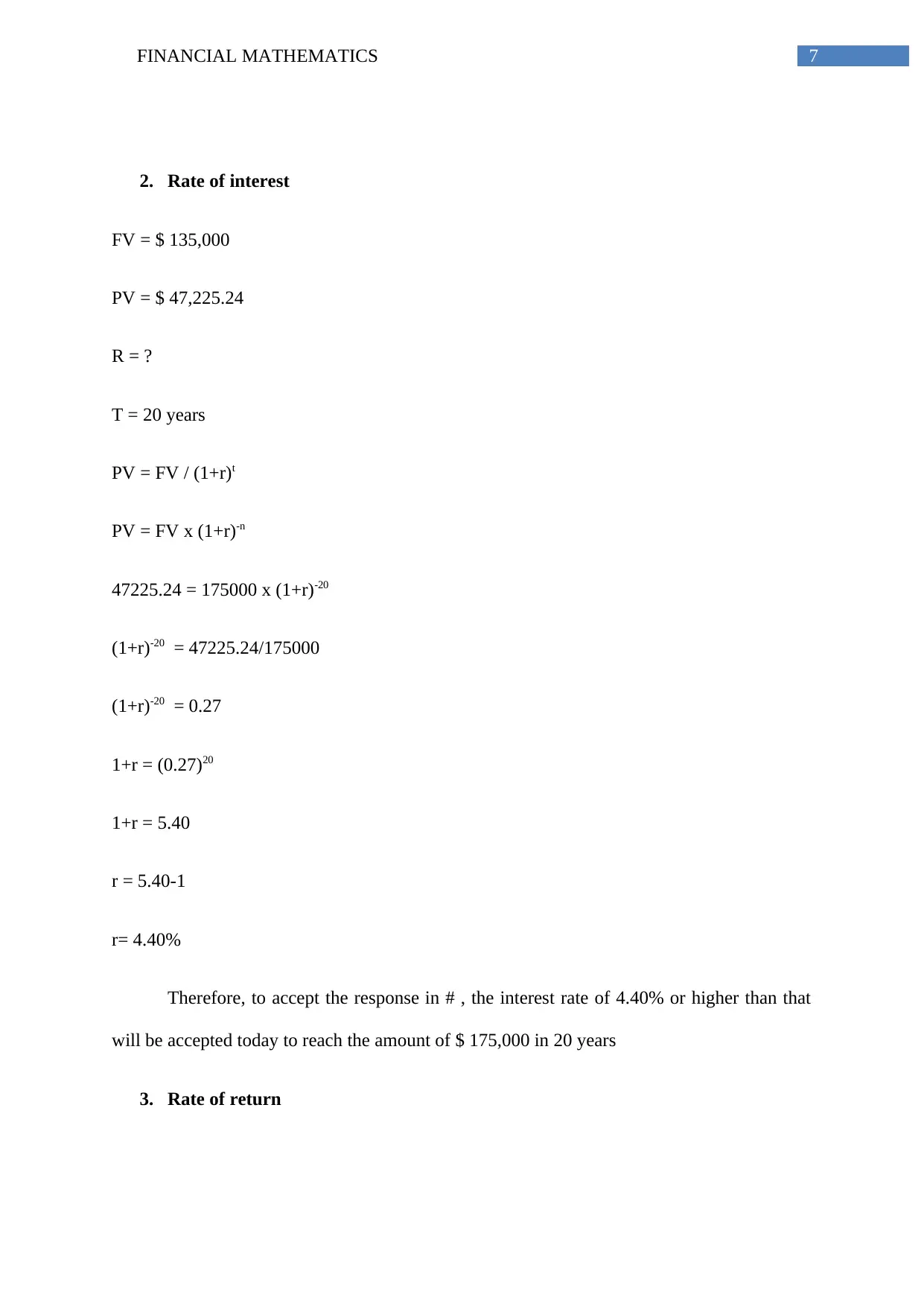
7FINANCIAL MATHEMATICS
2. Rate of interest
FV = $ 135,000
PV = $ 47,225.24
R = ?
T = 20 years
PV = FV / (1+r)t
PV = FV x (1+r)-n
47225.24 = 175000 x (1+r)-20
(1+r)-20 = 47225.24/175000
(1+r)-20 = 0.27
1+r = (0.27)20
1+r = 5.40
r = 5.40-1
r= 4.40%
Therefore, to accept the response in # , the interest rate of 4.40% or higher than that
will be accepted today to reach the amount of $ 175,000 in 20 years
3. Rate of return
2. Rate of interest
FV = $ 135,000
PV = $ 47,225.24
R = ?
T = 20 years
PV = FV / (1+r)t
PV = FV x (1+r)-n
47225.24 = 175000 x (1+r)-20
(1+r)-20 = 47225.24/175000
(1+r)-20 = 0.27
1+r = (0.27)20
1+r = 5.40
r = 5.40-1
r= 4.40%
Therefore, to accept the response in # , the interest rate of 4.40% or higher than that
will be accepted today to reach the amount of $ 175,000 in 20 years
3. Rate of return
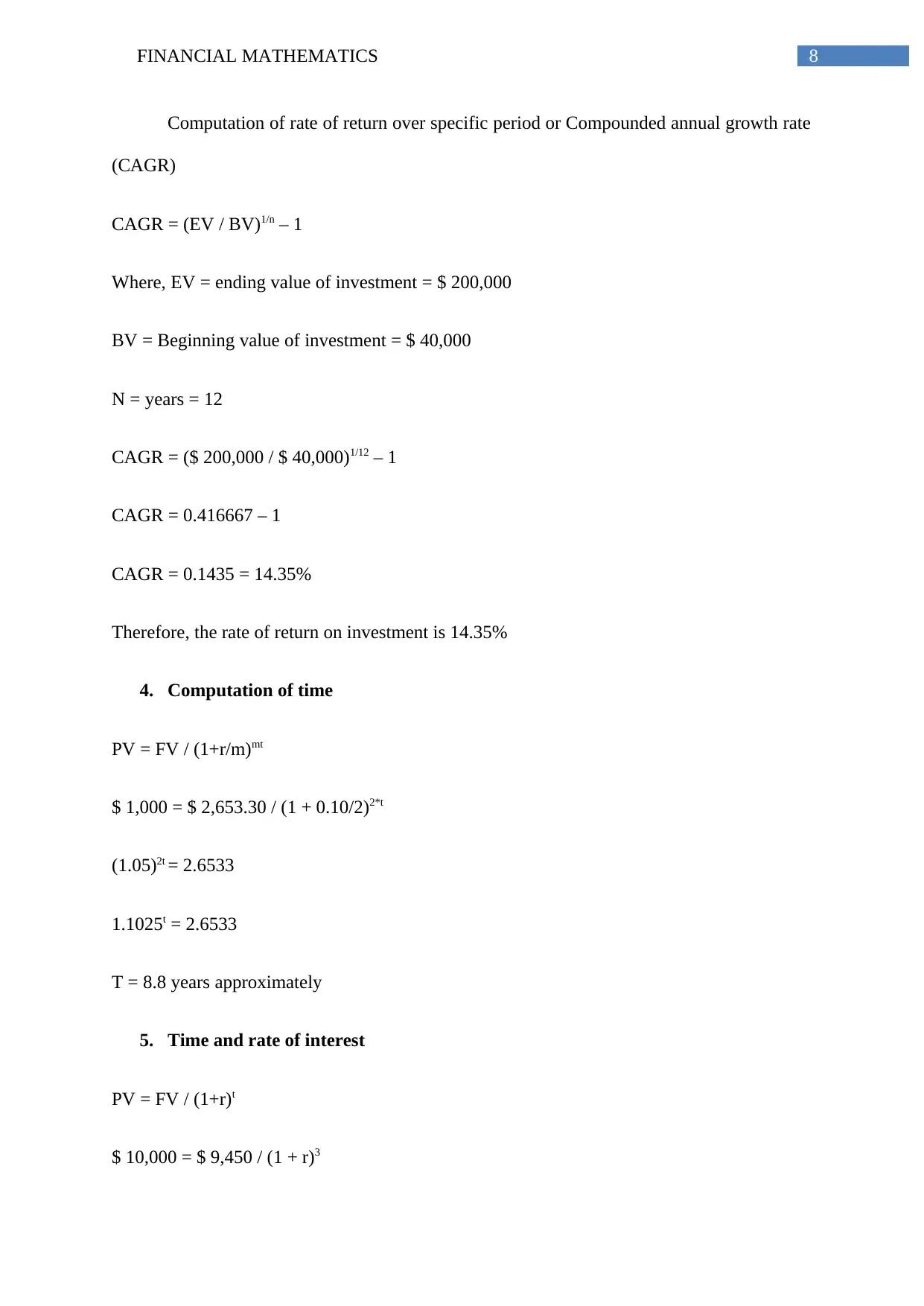
8FINANCIAL MATHEMATICS
Computation of rate of return over specific period or Compounded annual growth rate
(CAGR)
CAGR = (EV / BV)1/n – 1
Where, EV = ending value of investment = $ 200,000
BV = Beginning value of investment = $ 40,000
N = years = 12
CAGR = ($ 200,000 / $ 40,000)1/12 – 1
CAGR = 0.416667 – 1
CAGR = 0.1435 = 14.35%
Therefore, the rate of return on investment is 14.35%
4. Computation of time
PV = FV / (1+r/m)mt
$ 1,000 = $ 2,653.30 / (1 + 0.10/2)2*t
(1.05)2t = 2.6533
1.1025t = 2.6533
T = 8.8 years approximately
5. Time and rate of interest
PV = FV / (1+r)t
$ 10,000 = $ 9,450 / (1 + r)3
Computation of rate of return over specific period or Compounded annual growth rate
(CAGR)
CAGR = (EV / BV)1/n – 1
Where, EV = ending value of investment = $ 200,000
BV = Beginning value of investment = $ 40,000
N = years = 12
CAGR = ($ 200,000 / $ 40,000)1/12 – 1
CAGR = 0.416667 – 1
CAGR = 0.1435 = 14.35%
Therefore, the rate of return on investment is 14.35%
4. Computation of time
PV = FV / (1+r/m)mt
$ 1,000 = $ 2,653.30 / (1 + 0.10/2)2*t
(1.05)2t = 2.6533
1.1025t = 2.6533
T = 8.8 years approximately
5. Time and rate of interest
PV = FV / (1+r)t
$ 10,000 = $ 9,450 / (1 + r)3
⊘ This is a preview!⊘
Do you want full access?
Subscribe today to unlock all pages.

Trusted by 1+ million students worldwide
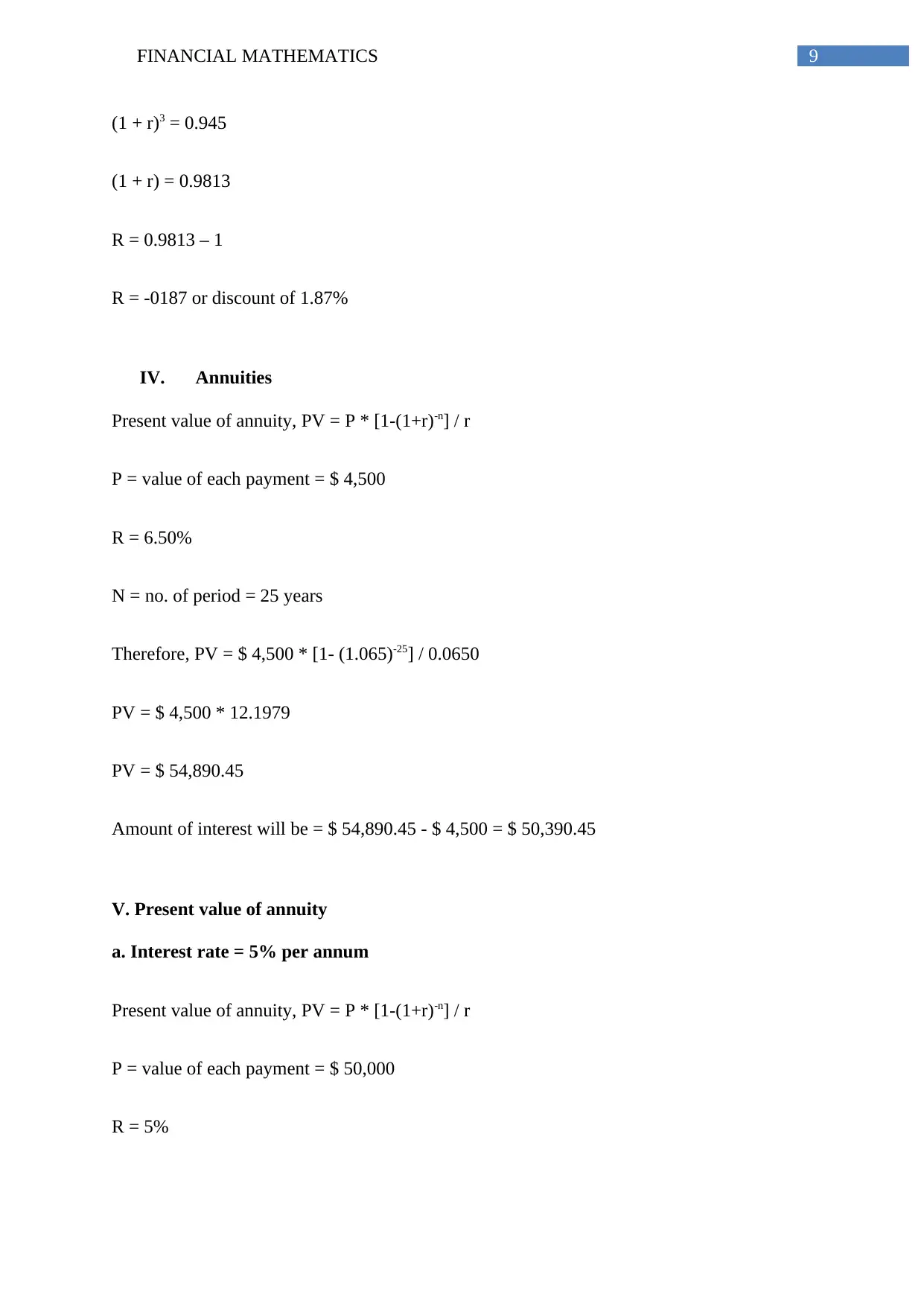
9FINANCIAL MATHEMATICS
(1 + r)3 = 0.945
(1 + r) = 0.9813
R = 0.9813 – 1
R = -0187 or discount of 1.87%
IV. Annuities
Present value of annuity, PV = P * [1-(1+r)-n] / r
P = value of each payment = $ 4,500
R = 6.50%
N = no. of period = 25 years
Therefore, PV = $ 4,500 * [1- (1.065)-25] / 0.0650
PV = $ 4,500 * 12.1979
PV = $ 54,890.45
Amount of interest will be = $ 54,890.45 - $ 4,500 = $ 50,390.45
V. Present value of annuity
a. Interest rate = 5% per annum
Present value of annuity, PV = P * [1-(1+r)-n] / r
P = value of each payment = $ 50,000
R = 5%
(1 + r)3 = 0.945
(1 + r) = 0.9813
R = 0.9813 – 1
R = -0187 or discount of 1.87%
IV. Annuities
Present value of annuity, PV = P * [1-(1+r)-n] / r
P = value of each payment = $ 4,500
R = 6.50%
N = no. of period = 25 years
Therefore, PV = $ 4,500 * [1- (1.065)-25] / 0.0650
PV = $ 4,500 * 12.1979
PV = $ 54,890.45
Amount of interest will be = $ 54,890.45 - $ 4,500 = $ 50,390.45
V. Present value of annuity
a. Interest rate = 5% per annum
Present value of annuity, PV = P * [1-(1+r)-n] / r
P = value of each payment = $ 50,000
R = 5%
Paraphrase This Document
Need a fresh take? Get an instant paraphrase of this document with our AI Paraphraser
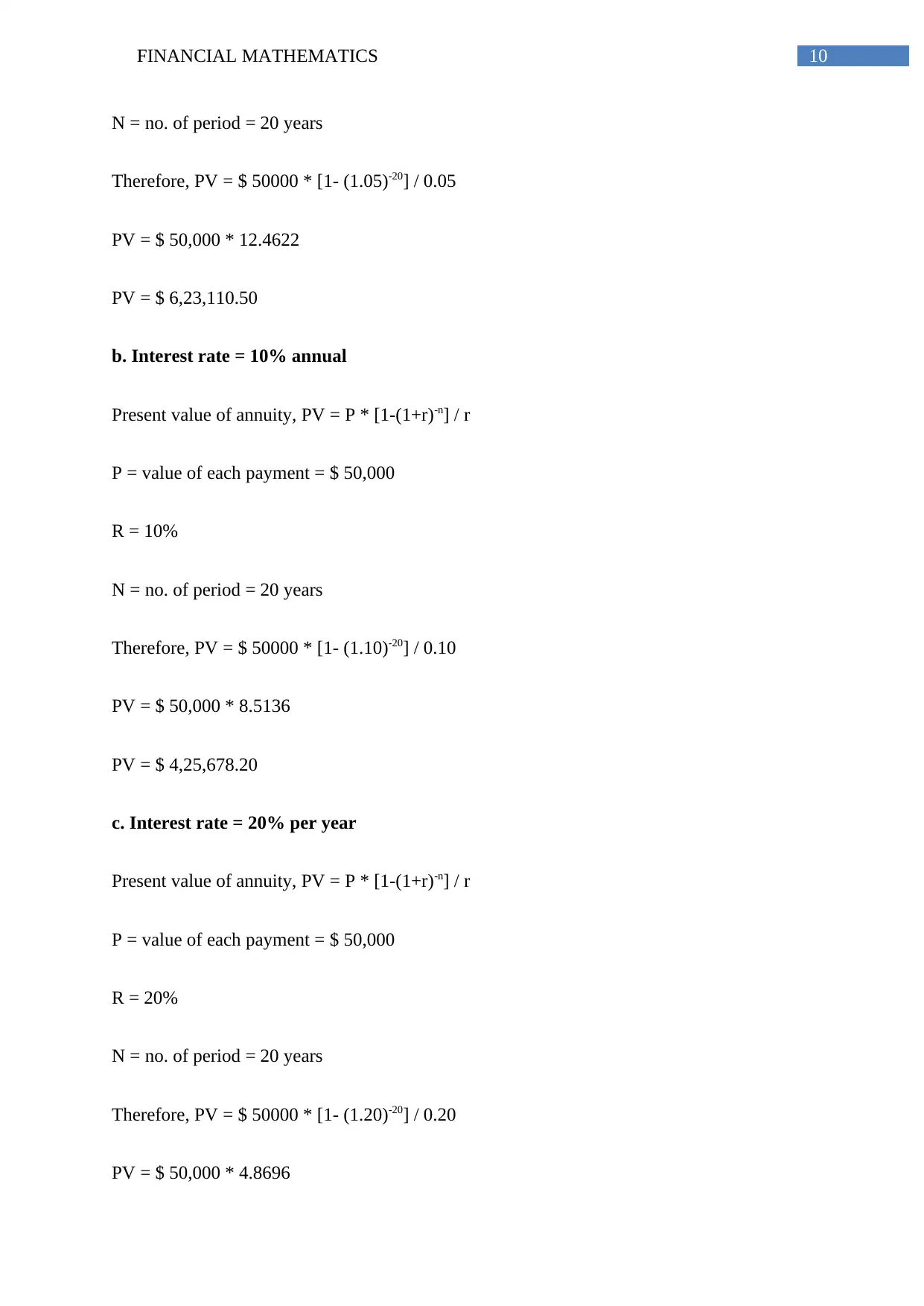
10FINANCIAL MATHEMATICS
N = no. of period = 20 years
Therefore, PV = $ 50000 * [1- (1.05)-20] / 0.05
PV = $ 50,000 * 12.4622
PV = $ 6,23,110.50
b. Interest rate = 10% annual
Present value of annuity, PV = P * [1-(1+r)-n] / r
P = value of each payment = $ 50,000
R = 10%
N = no. of period = 20 years
Therefore, PV = $ 50000 * [1- (1.10)-20] / 0.10
PV = $ 50,000 * 8.5136
PV = $ 4,25,678.20
c. Interest rate = 20% per year
Present value of annuity, PV = P * [1-(1+r)-n] / r
P = value of each payment = $ 50,000
R = 20%
N = no. of period = 20 years
Therefore, PV = $ 50000 * [1- (1.20)-20] / 0.20
PV = $ 50,000 * 4.8696
N = no. of period = 20 years
Therefore, PV = $ 50000 * [1- (1.05)-20] / 0.05
PV = $ 50,000 * 12.4622
PV = $ 6,23,110.50
b. Interest rate = 10% annual
Present value of annuity, PV = P * [1-(1+r)-n] / r
P = value of each payment = $ 50,000
R = 10%
N = no. of period = 20 years
Therefore, PV = $ 50000 * [1- (1.10)-20] / 0.10
PV = $ 50,000 * 8.5136
PV = $ 4,25,678.20
c. Interest rate = 20% per year
Present value of annuity, PV = P * [1-(1+r)-n] / r
P = value of each payment = $ 50,000
R = 20%
N = no. of period = 20 years
Therefore, PV = $ 50000 * [1- (1.20)-20] / 0.20
PV = $ 50,000 * 4.8696

11FINANCIAL MATHEMATICS
PV = $ 2,43,479
PV = $ 2,43,479
⊘ This is a preview!⊘
Do you want full access?
Subscribe today to unlock all pages.

Trusted by 1+ million students worldwide
1 out of 12
Related Documents
Your All-in-One AI-Powered Toolkit for Academic Success.
+13062052269
info@desklib.com
Available 24*7 on WhatsApp / Email
![[object Object]](/_next/static/media/star-bottom.7253800d.svg)
Unlock your academic potential
Copyright © 2020–2025 A2Z Services. All Rights Reserved. Developed and managed by ZUCOL.




